This page contains a photograph which is one of several belonging to the photo gallery pages which are part of several pages relating to the invention of the world's first automatic totalizator in 1913, its inventor George Julius, who was later knighted for his contribution to Australian Technology and Automatic Totalisators Limited, the company he founded to develop, manufacture and export these systems.
Copyright © 2014 Email - totehis@hotmail.com
The Automatic Totalisators Factory at Chalmers Street
This image is of the Automatic Totalisators Limited factory in Chalmers Street in the Sydney CBD next to Central Station. The Chalmers Street factory preceded the final factory, which was at Meadowbank and followed the factory in Alice Street Newtown. In December 2015 Narelle and I investigated the Sydney phone books to determine the years this factory operated. We visited the State Library of New South Wales which had Sydney phone books on microfiche from 1889 to 1950, which was very easy to use. In the November 1933 phone book the factory was still at Newtown and in the May 1934 phone book it was at this factory in Chalmers street. Therefore the factory moved from Alice Street in Newtown to Chalmers Street during the period at the end of 1933 to early 1934. In 1947 the factory moved from Chalmers street to a custom built factory located at Nancarrow Avenue Meadowbank in Sydney. There is an image of the Meadowbank factory further down this page. The 1947 move to the Meadowbank factory is confirmed in the Sydney phone book. The Meadowbank factory continued to operate until it was vacated after AWA Limited, another iconic Australian electronics engineering company that I had previously worked for, purchased the company in 1991.
Continued after the image...
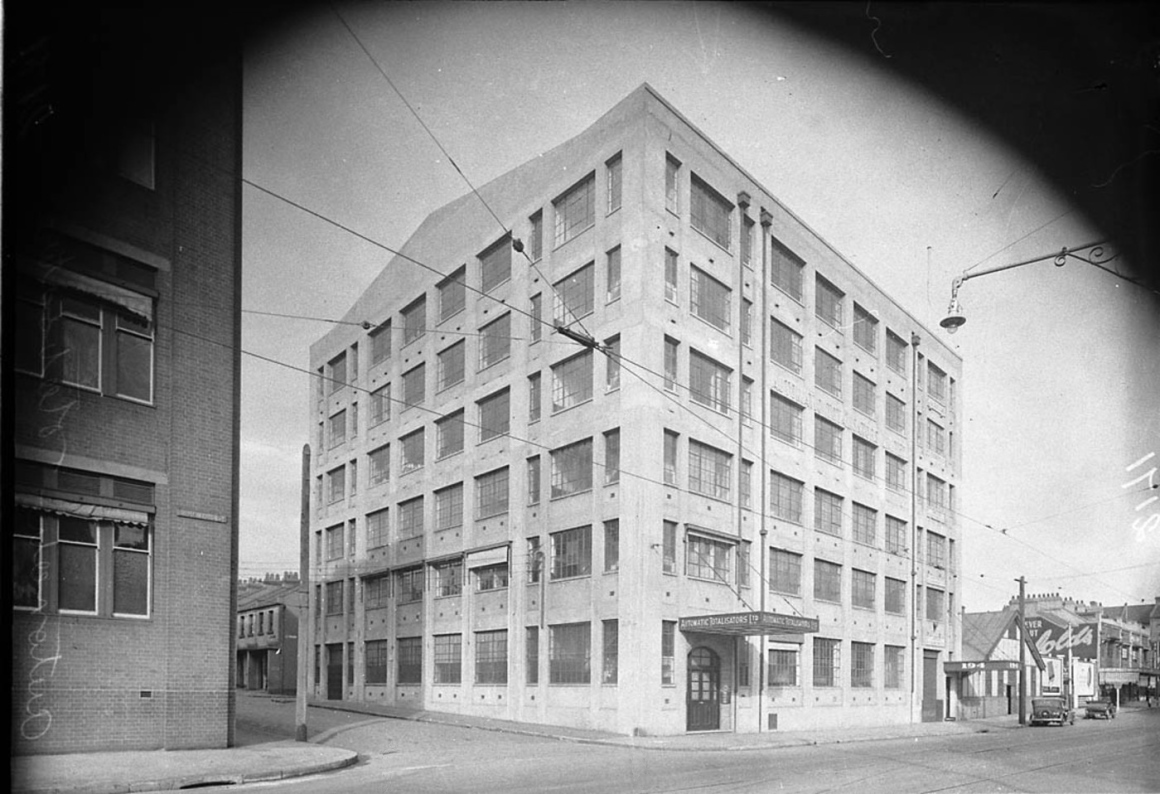
If you arrived from the Photo Gallery, Click on the image to go back to the photo gallery
If you arrived from navigating the website, use the navigation bar at the bottom of this page.
Image Source: State Library of New South Wales [Home and Away - 35251]
The photo was taken by Hall and Co.
First a terse review of company history spanning the period of the Chalmers street factory, with an extract from a company document. I discovered after the previous research into the period this factory was in operation, that this extract confirms the findings:
Immediately after the depression, Automatic Odds installations went to India, New Zealand and right throughout Australia. The first installation in the United States was made in 1932, when equipment was installed at Hialeah Racetrack in Miami, Florida. The second world war in the late 1930s put an end to totalizator manufacture and installation for almost 10 years. During the war years the factory, which had moved to Chalmers Street Sydney in 1933, went into full production for the Department of Defence and later the company expanded the munitions work to include tooling.
The knowledge gained in general manufacture and tooling during the war years was to serve the company in good stead immediately after the war, when it threw all its resources into tooling and manufacture of new totalizator equipment. In later years, when tote tooling work eased off, the toolroom turned to commercial work. This side of the business expanded rapidly until, the company had one of the largest commercial tool rooms in the southern hemisphere established on their premises at Meadowbank.
In late 1945, the company started in earnest to design totalizator equipment for post war use and, at this time, the J8 ticket issuing machine was born. The J8 proved to be a durable addition to the Automatic Totalisators terminal range. Up until October 1995, The Royal Turf Club of Thailand continued to use J8s as the on-course ticket issuing machine. Along with the ticket issuing machines, there was need for new designs in Mechanical Analogue Computers, Adders, Odds Relay Units and Indicators. The factory therefore, continued on at war time tempo for many years, in an attempt to fulfill the orders that kept rolling in. The company moved to the factory at Meadowbank in 1947.
And now we skip forward seventy years to 2017 when this webpage is undergoing further development:
It is clear that a preceding photograph in the photo gallery, with the associated text starting with Some staff outside the Chalmers Street Factory showing a group of staff members standing outside this building, was taken in Belvoir Street at the far left bottom corner of the building in this image.
The 1936 rate book records this Automatic Totalisators Ltd's factory address as 182/194 Chalmers Street. From this rate book document, the number of the assessment book is 21027, the name of the Owner or Landlord is Automated Totlisators Limited, it is categorised as factory and offices, it is constructed of concrete, it has one floor and three rooms and has a gross annual value in pounds of 1,759. Well that leaves a screaming question! How did this one floor building, become three, for the additional three stories mentioned in the following 1936 newspaper article, to result in a six story building?
Following is a newspaper article extracted from the Trove digitised newspaper website, which relates a major addition to this factory. I have not included the "accompanying perspective", however the final product is visible in the image above. In the newspaper, the artist's impression referred to as the "accompanying perspective", is titled ENLARGED PREMISES OF AUTOMATIC TOTALISATORS LTD.:
1936 'BUILDING AND CONSTRUCTION THREE NEW STORIES.', The Sydney Morning Herald (NSW : 1842 - 1954), 16 June, p. 3, viewed 12 May, 2015, http://nla.gov.au/nla.news-article27990765
BUILDING AND CONSTRUCTION
THREE NEW STORIES.
Automatic Totalisators Ltd.
Three additional stories are being added to the premises of Automatic Totalisators Ltd., 182 to 194 Chalmers-street, Sydney. This addition, as shown in the accompanying perspective, will bring the building to a height of six stories. A second elevator will be installed to give the additional transport necessary for the upper floors.
The additions will be in reinforced concrete on the mushroom system, with no ceiling beams and few columns, thus giving the maximum amount of light reflection. The windows will be in steel frames of large area, on three sides of the building, ensuring excellent light to the 10,000 square feet of floor space on each added floor.
Construction work is being carried out by Alex Speers and Sons, Ltd., to plans, and under the supervision, of S. H. Buchanan, Cowper and Morgan, architects, and A. Morrison, structural engineer. The additions are to be completed by September next.
It is interesting to note the power lines for the Tram in the image above. I lived in Sydney for fourteen years starting in 1964 and the trams had all gone. My wife was born there and does not remember the trams. We both remember the trams in Brisbane, where I spent most of my time working for Automatic Totalisators Ltd., however they too are now long gone.
Following is information on two people who worked at this factory. The first, Spencer Grace spent a lot of his time as the Managing Director, the second, Danny Alexander was an apprentice. This presents an interesting contrast, as Spencer was at the top of the hierarchy and Danny, just starting out on his career, was at the opposite end of the hierarchical structure. Interestingly Spencer and Danny worked at the above factory at the same time during WW2, although Spencer had a much longer tenure.
Spencer Grace - Automatic Totalisators GM-MD at the above factory
In August 2008 I received an email enquiring if I had any information regarding an ex ATL General Manager Spencer Grace who was involved with Automatic Totalisators Limited from the 1930s to the 1950s in Chalmers St in the Sydney CBD and the Meadowbank factory as well as overseas, particularly the USA. At the time I did not know the name. When I enquired if Neville Mitchell knew of him he sent the following reply:
I never had the opportunity of meeting Spencer Grace, However he was very well thought of in the Automatic Totalisator company. He was the general manager of the new Meadowbank factory and I think he was instrumental in its design and construction. In 1962 when I joined the company he was still referred to in relation to past totalisator installations such as Caracas.
Spencer was a rower and he was often in the news competing in sculling events including the Olympic games, Even in his eighties he was still training young rowers.
I can not name any who would have known him personally, the people who would have worked with him such as Don Hardie, Joe Norris, Milton Jarvis, have all past on.
In 2015, I happened upon Spencer's obituary and realised that he was a very interesting character. Added to this, in 2014 I had discovered that the old Automatic Totalisators factory in Chalmers Street Sydney, was still standing. As this building was Spencer's domain it seemed logical for me to present this information with the image of this factory. Following are extracts from two obituaries:
Date: 23/10/99 - Spencer Grace OAM - Olympic rower, 1907-1999
Information extracted from Spencer's obituary written by Philip Grace:
The last time Spencer Grace rowed on his beloved Lane Cove River was just three weeks before his death - at the age of 92. A businessman and sportsman, Grace represented Australia at the 1948 London Olympics. His partner then was Ted Bromley of Palm Beach and the duo, dubbed "the gruesome twosome", still rowed together well into the 1990s.
While studying accountancy, he became captain of his local tennis and swimming clubs; practice for the latter included diving from the old Roseville Bridge and racing the sharks to the Roseville Baths (where, years later, his sons learned to swim).
Work, too, was going well; at 19, he came sixth in NSW in his accountancy exams, waited two years for admission to the Institute of Accountants, and worked with some of the city's larger practices.
A keen motorcycle racer, he sought a competitive edge by machining parts for his bikes, which served to whet his appetite for engineering. As the Depression bit, he launched, with Roy Burns, Spencer Grace & Co at 175 Pitt Street, a branch of which specialised in a then growth market - motor trade debt collections.
It was about then that he discovered rowing. It was a winter's evening, already dark, when he arrived at the deserted North Shore Rowing Club in Neutral Bay. He paid his dues to the caretaker, against whose wishes he then took one of the club's skiffs, a narrow vessel, not for beginners. Never having rowed before, he struck out into the busy harbour on a course which brought him into dispute with one of the many ferries (completion of the Harbour Bridge was still two years distant). A collision was avoided but Grace capsized; a passing Italian fisherman returned him, with skiff, to Neutral Bay.
By 1934 he had become captain of the club and would remain in that position until the outbreak of World War II. Those were its golden years, with the unique double in 1938 of the State championship eights and the State premiership pennant.
On the professional front, he'd sold out of private practice and become company accountant with Automatic Totalisators Ltd. He would swiftly become ATL's general manager, putting his meteoric rise down to having become "repulsively organised and pedantic".
At the outbreak of WW2, he tried to enlist in the RAAF but ATL had been declared essential to armaments production; under Grace's direction it would produce parts for all manner of weapons from howitzers to Mosquito fighter-bombers.
With the war over, ATL returned to making tote machines; Grace became managing director and with his war experience and study at Sydney Technical College (now the University of Technology, Sydney) was admitted to the Institute of Production Engineers and the Australian Institute of Management. There was constant air travel as ATL built markets in India, Africa, the Middle East, North and South America, Europe and Britain.
The pinnacle of his sporting success came in 1948 with the London Olympics, with Bromley in the coxless pairs. Though he didn't compete at the 1952 Olympics, he played a key role in the success of the Australian eight, most of whom would be the honour guard at his funeral.
After the 1956 Melbourne Olympics, Grace retired from ATL but not from work, setting up marketing firms in the US and working with a scrap-iron and foundry firm at home.
He retired again in 1985 but not from rowing; when 78, he rowed in the first World Masters' Games in Toronto, winning silver and bronze medals. At 84 he competed in the third Australian Masters' Games in 1991 and won two gold and a bronze. He outdid himself in the World Masters' Games in Brisbane in 1994; then 88, he won two gold, three silver and two bronze medals.
Webmaster's note: this obituary written by Philip Grace was published in the Sydney Morning Herald.
Information extracted from an obituary written by Maurie Grace:
Frederick Spencer Grace was a most unique person, who, as an Olympian has had quite an impact on Australian sport. His professional and business activities have, as well, impacted on Australian history.
Spencer was studying to gain his accountancy degree when he became immersed in motor cycle racing. Prior to World War 1I he was offered the position of Accountant for the multinational public company, Automatic Totalisators Limited. He was later appointed Secretary of the Company and then General Manager. Following the war, the horse racing industry was ready for the expansion of its totalisator betting facilities on numerous race tracks in virtually all countries of the world. And, Spencer, as Chief Executive of the Totalisator Company, was charged with selling the world on the advantages of the Australian Totalisator.
After some 20 odd years as Chief Executive Officer of the Totalisator group of companies in Australia, UK, USA and France, Spencer retired. During his leisure travels in the US after retiring he became impressed with the way many Americans handled the problem of the daily or weekly laundry. Self-service laundries were everywhere in the US yet there were none in Australia. He began to research the industry and he eventually entered into an agreement with Westinghouse International to distribute their machines in Australia. This resulted in the first self-service laundry and dry cleaning stores in the Southern Hemisphere being opened in Neutral Bay. Then "laundromats", as they are known, were installed in most suburbs in all States in Australia. Spencer's initiative revolutionised the chore of cleaning clothes Australia wide.
Another chapter in Spencer's life follows. It deals with the hours when he was not at work. At play, Spencer was not satisfied with half measures. After some success in football, tennis, swimming and, of course, motor-cycle racing, Spencer became involved in rowing and skiing. He has been a member of an International Rowing Team on two occasions. In 1939, he was a member of the eight-oared crew from Australia, representing the Sydney Club, which competed in the 100th Anniversary Regatta at Henley-on-Thames. In 1948, at 41 years of age, he competed for Australia in the coxless pair oar crew at the 14th Olympic Games. Spencer represented NSW in the King's Cup on two occasions. He has won many elite and championship races both as a crew member and a coach. In 1937, he had the distinction of representing NSW both in its rowing team and its skiing team and was then selected to represent Australia in both sports.
Spencer has been a Member of the North Shore Rowing Club since 1930 and of the Kosciusko Alpine Club since 1935. During the period 1934-39 he was Captain of the Rowing Club, and it was during such period that his Club won its only State Champion eights and State Premiership Pennant in the same year. Spencer has been President of North Shore for over two decades and watched over the Club's finances as its Hon. Treasurer for a period of 22 years. He stepped down as President in 1998 at the age of 91.
He has also been the Club's delegate to the NSW Rowing Association for a virtual life time. In recent years, he has been one of the Rowing Association's Vice-Presidents. He was an accredited Boat Race Official for the Australian Rowing Council for many years. From 1968, he was accredited as a Judge for FISA, the international governing body for rowing worldwide. In 1972 for the Olympic Games in Munich, he was selected by the Australian Rowing Council as the sole Boat Race Official to represent Australia on the International Jury for rowing. Spencer has been an active member of the Union of Old Oarsmen in NSW for many years. He has occupied the position of President of the Union and was still a member of the Committee of that body.
During the last several decades, Spencer has been competing in State, National and International Veterans/Masters Regattas. He has won numerous Gold, Silver and Bronze medals at such regattas. Special mention might be made of the first World Masters Games held in Toronto, Canada in 1985, where he won Silver and Bronze medals. At the Third Australian Masters Games held in November, 1991 in Queensland, at the age of 84, he won two Gold and one Bronze medal The World Masters Games came to Brisbane in 1994 and Spencer was again a competitor in his 88th, year. He competed in nine separate events over the three days and won two Gold, three Silver and two Bronze medals.
For the final chapter in Spencers' sporting career, he was included in the Queen's Birthday Honour's List in 1994 when he was awarded an Order of Australia for services to rowing.
Webmaster's note: Maurie Grace is a long time Member of North Shore Rowing Club. This obituary he wrote was delivered at Spencer's funeral.
Newspaper clippings re Spencer Grace
The first article below attests to the globe trotting nature of the business of Automatic Totalisators Ltd. as alluded to in both of Spencer's obituaries above.
The second article refers to Mobile Units Being Built. These mobile totes were a significant product line for Automatic Totalisators Limited and there is a chapter dedicated to these in this website titled The Julius Premier Totemobile. To view this, select the Go to the index option in the navigation bar at the bottom of this page and select the specified chapter.
The last two articles below, make reference to Automatic Totalisators in the United States. There is a chapter in this website dedicated to the Automatic Totalisators Limited's subsidiary in America titled Automatic Totalisators in America. To visit this page follow the procedure at the end of the above paragraph.
The last article shows Spencer leaving Automatic Totalisators in Australia to join the subsidiary company in the United States. This is in keeping with Phil Grace's observation in the following extract from one of his emails:
I'm still working on Spencer Grace's bio. and have access to his personal diaries for the period from 1951 onwards. If you feel reference thereto may assist your cause please let me know, although most of it refers to ATL(USA) & other international installations.
The newspaper articles follow:
1948 'More Betting Overseas.', Kalgoorlie Miner (WA : 1895 - 1950), 8 March, p. 4, viewed 6 May, 2015, http://nla.gov.au/nla.news-article95566435
More Betting Overseas
Sydney, March 7.- Race course betting overseas had increased tremendously since the war, Mr. F. Spencer Grace, managing director of Automatic Totalisators Ltd. said to-day when he returned by Qantas Constellation.
The increase had been most marked in France, India and Singapore, and to a lesser extent in South America
He had received big orders for Australian-made totalisators from Indian, Malayan, Philippine, South African, New Zealand and South and North American racing clubs
1949 'AUTOMATIC TOTE.', Kalgoorlie Miner (WA : 1895 - 1950), 11 February, p. 8, viewed 7 May, 2015, http://nla.gov.au/nla.news-article95714596
AUTOMATIC TOTE
Mobile Units Being Built
SOLVE DIFFICULTIES OF COUNTRY CLUBS
A mobile automatic totalisator that can be driven from one country centre to another at up to 40 miles an hour is being built by Automatic Totalisators Ltd. (Sydney). It will be the first of a fleet of 20, each of which will handle £15,000 a day.
Mr. Spencer Grace, managing director of Automatic Totalisators, said this was his company's answer to the difficulties of country racing clubs considering installing automatic totalisators.
The mobile machine could operate at a race meeting in the day and move on to a dog track or pedestrian meeting at night, he said.
All the clubs would have to provide would be a concrete apron 40 ft. by 16. ft., on which to operate the machine.
The machine has a built-in odds indicator on all runners for a win and a place. At one end will be the self-powered calculating unit, and at the other the bank and inquiry office.
Automatic Totalisators Ltd. will provide staff and all facilities. The machine will be worked on a percentage basis without cost to the club.
The "prime unit," as the traction power is called, is a Diesel motor and is detached during a meeting. Skirts are let down on the sides of the tote, giving it a compact appearance. It can provide £1, 10/ and 5/ windows or bets of any other denomination.
One side of the tote has pay-out windows or, alternatively at a big meeting, both sides can be used as selling windows and a club building could be used for the payment of winning bets
Length of the vehicle over-all is 45 ft. Operating unit is 35 ft. by 8 ft, and 11½ ft. high.
Full racecourse operating totes are being erected by the Australian company in Brazil, Columbia, the United States, New Zealand, India, Burma, Malaya, the Philippines and South Africa.
Twenty-six totes are to be erected in Australia--five in Western Australia, two in South Australia, eight in New South Wales, six in Victoria and five in Queensland.
1950 'Arrivals from overseas.', Truth (Sydney, NSW : 1894 - 1954), 17 December, p. 48, viewed 6 May, 2015, http://nla.gov.au/nla.news-article167984787
Arrivals from overseas!
Olympic sculler and managing director of Automatic Totalisators Ltd., Mr. F. Spencer Grace (above), returned last night from a five months business trip to America. "Our tote machines are popular in the U.S.," Mr. Grace said.
We have one installed there, and negotiations are almost completed for another two to be sent to American race courses. "These machines are a great dollar-earner for Australia," he added.
1954 'APPOINTMENTS.', The Sydney Morning Herald (NSW : 1842 - 1954), 7 October, p. 9, viewed 6 May, 2015, http://nla.gov.au/nla.news-article18460228
AUTO. TOTARS., U.S.A.
Mr. Spencer Grace has relinquished the position of managing director of Automatic Totalisators Ltd. in order to concentrate on the position of managing director of Automatic Totalisators (U.S.A.) Ltd.
Mr. A. A. Boa has been appointed general manager of Automatic Totalisators Ltd.
Emails regarding Spencer Grace
On May 6 2015 I received an email from Malcolm Coutts Vice President of the North Shore Rowing Club, after I contacted the club regarding Spencer, as Spencer Grace has a long history there. An extract from this email follows:
Brian, this is an interesting email so I thought I would respond. I have an interest in the club history and I know that Spencer gets many mentions in trove.gov.au. I was just an ordinary rower but Spencer did coach me for 12 months around 1987 /88 and I was inspired at him being in a tinny in his 80s out on the water yelling at us. He even came out in a tub with me once. And dropped me from a crew for catching a crab in a race at Leichhardt. I have always told my wife my goal is to row at his age.
There were a number of periods post world war 2 where the club was on its knees and Spencer kept it breathing.
On May 10 2015, I received some emails from William Johnson regarding Spencer Grace. William worked for Automatic Totalisators Limited as an engineer and manager in Melbourne, Canada, USA, Venezuela and Malaysia spending almost ten years overseas on totalisator installations and operations. His father, also William Johnson, also worked for Automatic Totalisators. Following are some extracts from William's email:
I remember Spencer Grace and can still remember his face. A gentleman.
1948 I remember he and my father travelled to London. Olympic Games time. They demonstrated ( multi value issuer or new adder I cannot remember) new totalisator equipment. We have seen a photograph of the occasion. I still have the Olympic Games stamps my father gave me on his return, as 4 kids we were always greeted on his return from travel with presents. When in the USA office Spencer re-married, his (secretary) Eileen O'Grady if my memory is working. My father had an agreement with Spencer to race me home to Australia if I reached military call up age.
I remember Spencer Grace from 1954 when I began my apprenticeship, to the day when Ileen Cooney (from the office, social secretary) sent to me many years later, his obit from the newspaper. I rarely spoke to Spencer but he always said hello when passing. I think there may be a memorial to Spencer somewhere on or near the harbour. I know there was a memorial to a sculler on the way to Manly by ferry.
Long time ago. On my way to Caracas in 1957? Alf Boa was visiting in the Wilmington office. He also visited us in Venezuela along with Joe Norris and Don Hardy between 1957 and 1960 more or less.
On 23 May 2015, Neville Mitchell, a long serving Automatic Totalisators Ltd Engineer and Manager, sent me a comment regarding Spencer Grace. I worked in the Meadowbank factory that Neville mentions, however with a head full of contemporary tote problems I was completely unaware at the time of the hallowed ground I trod. This was home to giants of industry in a company that had so many Australian achievements! Neville's recollection of Spencer Grace follows:
I never met Spencer Grace, I did see him sculling on the Parramatta river in front of the Meadowbank factory, when working overtime which was quite often. Spencer would be spotted by one or more of the staff who had worked with him, word would be spread around and we would all flock to the windows to watch him smartly skimming the river between the rail and road bridges.
On 19 June 2015 Rod Richards, a long serving Automatic Totalisators Limited engineer who joined the company in 1949 as an apprentice, sent an email with information regarding Spencer Grace. Rod was at the Meadowbank factory that Spencer was probably instrumental in designing and constructing, as Neville Mitchell indicated previously in this page. Rod refers to Spencer as visiting, presumably from the Chalmers Street Factory as they probably coexisted for a changeover period. Rod's information follows:
From your research I now understand a lot more about Spencer Grace. In my time at the factory I never knew much about Spencer Grace only that he was the GM-MD and did visit Meadowbank, which was evident by his car being parked in the driveway from time to time in front of the entrance to the building. As a piece of trivia, Spencer Grace's car at the time, was a 1948 Black Buick Straight 8 and is shown parked in the driveway in the "photograph of the factory" from your Totalisator History website.
The black Buick that Rod refers to can be seen parked outside the factory in the image below.
One final comment regarding Spencer Grace: In December 2015 whilst in Sydney for the Automatic Totalisators Limited reunion dinner, a good friend of ours Warwick Halcrow, an ex-ATL systems programmer, invited Narelle and I to attend a get together of his friends at a coffee shop in Lane Cove. We met Warwick's delightful friends and engaged in many interesting conversations. At one stage I was talking to Warwick, with Jim and Margaret listening in, relating the fact that I had visited the North Shore Rowing Club's boat shed whilst in Sydney and asking if Warwick would like to join Narelle and I in a visit there at 0630 when it opens. I was getting to the punchline about Spencer Grace, an Olympic rower and benefactor to the North Shore Rowing Club, having also been a GM and MD of ATL, when Jim blurted out "Spencer Grace" before I had time to mention it. I could not believe it, what a coincidence! Jim already knew of Spencer, his sporting prowess, his association with the North Shore Rowing Club and his career with ATL. Jim did not regard this as particularly remarkable, he thought it was common knowledge amongst the Lane Cove set.
The Meadowbank Factory and Spencer's Buick

In the Memories of the Factory chapter of this website, Neville Mitchell refers to this Buick as Alf Boa's company car. As Alf took over from Spencer Grace when Spencer moved to the United States as MD of Autotote, ATL's American subsidiary, Alf probably inherited this car.
Earlier, in August 2013 Rod Richards had written about his time at Automatic Totalisators Ltd. I have included it here as it places it with his observation above. Additionally, it relates that he was an apprentice and the next segment from Danny Alexander is a good indication of the life of an apprentice in those days. Rod's company recollections follow:
I started at ATL in early January 1949 as a 17 year old second year apprentice as I had to transfer from a small Press Metal shop that had to close its doors and I was left without a job. This however was a blessing in disguise as not long after I started my first year, the company moved to a larger shop at Matraville from Clovelly and at about the same time my family moved from Annandale to Ermington near West Ryde. This left me with a massive amount of travel each day to get to work and to go to Tech at Ultimo a couple of nights a week; my 30 shillings a week wage went mostly on fares; I soon became disenchanted with the whole affair.
I could not believe my luck when I was accepted at ATL, to continue my Apprenticeship, this massive modern almost new factory, certainly beat the hell out of the old Fibro shed that I had just left, also ATL was just a bike ride from home and a new Tech College had just started at Meadowbank, fate and my fairy godfather was certainly looking after me.
On my first day at ATL I was introduced to man in charge of the Adders, Fred James an old Tote man whose first words were "Rod, I do not care how long it takes, but it must be done right"
I still remember those words as I still tend not to take short cuts. Although 'take your time' was not quite right as Totes was at the time super busy with a number of jobs in the pipe line and overtime being worked. I recall that towards the end of the year 1949, the Randall Park job in the USA was top priority as it had to be completed before a certain date to meet the racing carnival or severe penalties would apply, I think we even worked Boxing Day and air freight was involved.
I worked mainly with the Adders and not to ramble on for too long a couple of things stick in my mind; One is the Number Counter mounted on the Adder, this was commonly known as "The Veeder" as the Counter was made by Veeder - Root and the name Veeder just seemed to stick.
As Rod mentions assembly below, I have included an image of one of the assembly sections in the Meadowbank factory below.
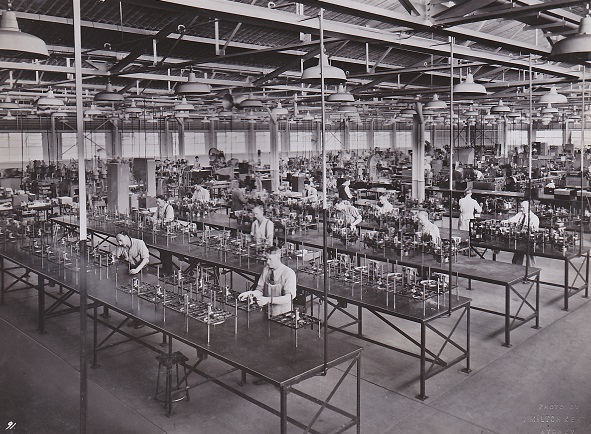 Part of the Assembly Section
Part of the Assembly Section
The Escapement Shaft was also an assembly that required some careful assembly as the brass bevel gears had to be de burred so that they ran smoothly when assembled, this was done with the aid of a fine knife file. The Escapement Wheels were also assembled to the Cross Head with four BA Csk Hd screws with a similar product to Loctite. Once the assembly was completed the unit was then 'Run In' mounted in a fixture in an enclosed tank and run with a light oil as a lubricant. Each Escapement Wheel was locked off in turn to ensure that all the bevel gears were being run in. The end result was that the whole assembly was like a piece of silk to turn. Alf Burnell was the man that took a personnel interest in each Escapement Shaft that left his care.
Those were the days!!
 Go back to the index
Go back to the index
 Go to the bottom of the page
Go to the bottom of the page
Danny Alexander - Automatic Totalisators Limited Apprentice
Below is an interview that Bill Bottomley performed with Danny Alexander who worked for Automatic Totalisators Limited, in the factory shown at the top of this page during World War Two.
I found the following interview conducted by Bill Bottomley on his website titled Bill Bottomley's Cyberfiles, which is one of his What Did You Do For a Crust interviews. Bill has kindly allowed me to reproduce this extract relating to Danny's experience as an apprentice in the Chalmers Street factory. I have placed a link to Bill Bottomley's website, in the links chapter of this website.
The following interview is historically interesting for a number of reasons. It gives an idea of how hard life was as an apprentice, not only during the war but afterwards as well. This hard life as an apprentice is also observed by Neville Mitchell in other pages of this website. Additionally it demonstrates the dictates of war such as the windows being blocked out.
In September 2014 I visited the War Memorial in Canberra. I stood under a Mosquito fighter/bomber, one of my favourite aircraft, knowing that Automatic Totalisators had manufactured parts for aircraft during WW2, however I did not realise they had been manufacturing parts for this famous aircraft as indicated by Danny.
This interview also demonstrates the pioneering development work in industrial processes that was being done at this factory as well as an emerging standard of conduct for the following Meadowbank factory era. I have not edited the content of the interview to comply with the ways of polite society or political correctness nor explained colloquialisms, as I think that would be tampering with the historical value of this document. I have masked the blaspheming however. Neville Mitchell, a long serving ATL Engineer and Manager wrote: Swearing was never allowed in ATL Meadowbank. Using a four letter word was a sackable offence. Danny's story possibly points to its origin. This interview also portrays a story of a teenager who found his niche.
Extract from Bill Bottomley's interview with Danny Alexander
Then towards 1943 I think it was, at the peak of the war, we had to go through the manpower controls at that time. I had a bit of a leaning towards metalwork, particularly machining (I was good on a lathe), and I got an apprenticeship with Automatic Totalisators. I didn't really want it - I wanted to join the navy, but you couldn't do what you wanted to do. I had to go for a test in Sydney. It was a test to sort out what you were best suited for and they channelled you in that direction. It was as a result of that test that I got the apprenticeship. I've still got the original indenture, dated May 1944. It was a five year apprenticeship, and I started working there in 1943. You had to do twelve months before they made you a full apprentice, but that got counted in at the end when you came out as a fully qualified fitter and machinist.
The first three years entailed three nights a week at the Tech. at Ultimo. The day would start at six in the morning. It was a mile walk to the tram, then you got the tram to Burwood Station, then the train from Burwood to Central, then you'd run up to Chalmers Street to where the factory was. The building itself was all bricked up - there was no natural light in it at all. The building's still there - up the top, before you get to Cleveland Street. It was a rough, tough old place then, I can tell you.
We were making parts for Mosquito bombers. They were of wooden construction, but everything in the plane was built in different parts of the country and assembled at...I'm not sure but I think it was at Lidcombe. They had what they called a tail weight in it that weighed about sixteen pounds. It was a cast iron weight that went at the back to give the plane balance and stability. It came as a rough casting, and one of the jobs the apprentices had was to grind all the dags off them. You had to stand at a bloody great emery wheel without a guard on it, and no goggles, and no respiration protection or anything - you just stood there and copped the iron dust, and you'd spend the whole day picking these things out of a box and grinding the dags off them.
It was pretty well all production work that we did. Sometimes you'd spend a couple of weeks doing the one thing all the time, which was deadly monotonous and soul-destroying. We started work at seven fifteen - it was nominally a 44 hour week. We'd work through till nine, when the whistle blew and you got ten minutes for morning tea. You had a minute and a half to get from your machine to where you had smoko, and a minute and a half to come back. If you went to the toilet - (the toilets only had half-doors on them so that if you were there a long time they could come and check up on you and make sure you weren't reading the paper or anything) - and if you took more than seven minutes on the toilet the charge hand would want to know if you were crook, and if you were crook you had to get a doctor's certificate because you couldn't spend a long time on the toilet - even if you did have a stomach-ache. You'd go back to work at ten past nine and you'd work through till twelve.
At twelve the whistle would go and you could do what you liked for half an hour, then at twelve thirty you'd hit the button on your machine again. You could buy a pie and things like that, but we usually took our own - especially the kids, because we only got twenty one shillings a week. You worked through the afternoon till seven minutes to five, precisely - (there was no afternoon smoko) - when the whistle went again, and in that seven minutes you cleaned your machine up. You also had a key ring with brass dockets on it. You got ten tool dockets, numbered from one to ten, with your serial number on it. Mine was 103 - I'll never forget it, it was like being in gaol. In the mornings you'd line up and clock on before seven fifteen, and then you'd pick up your tool dockets. When you knocked off in the afternoon you handed your tool dockets in, and if there wasn't ten tool dockets you didn't knock off till you found the tool that you had out of the store and hadn't returned. So you couldn't knock anything off, naturally. You clocked off at five on the knocker.
From there, on Monday, Wednesday and Friday nights I had to go to the Tech. at Ultimo. I'd go across Railway Square and past the old Glaciarium and down Harris Street, and pick up a pie and half a pint of milk on the way. Then you'd do three hours tech. I'd leave there after nine at night and get the train back home again. In the wintertime I never saw the sun for five days a week. We were walled in completely, with incandescent globes over our workplace - though there were floodlights in the ceiling. I liked using the machines, but I detested the environment. As far as I was concerned it was like a gaol term because I really wanted to be in the navy. See, the uncle of mine who was like an older brother was killed early in the war at the battle of Matapan - he was blown off the Perth by strafing from an Italian Stuka while he was running searchlights. Being an impressionable kid, all I wanted to do was go and take vengeance for his death. So the first five years I spent at work was sheer bloody hell as far as I was concerned. I detested it.
On one particular occasion the foreman in the machine shop, a brilliant machinist named Arch Rimoldi - he was an absolutely brilliant tradesman, but a very, very hard man. They put me on this little South Bend lathe - a little benchtop lathe - and they brought me around a kerosene tin full of little silver steel bushes. They were a quarter inch diameter by a quarter inch long with a little shoulder on them, and a sixteenth hole through the middle. These were part of an extrusion machine for making sixteen gauge copper wire, and because of the abrasiveness of the extrusion process these dies wouldn't last long and they used to make them by the thousands. My job was to put a little chamfer on that little sixteenth hole. It had to be precisely the right depth and diameter, and it had to have a mirror finish on it. That's done on a slow speed on the lathe with a special countersinking tool on the tailstock, and it was a pretty precise job and you had to watch it closely. There was 100% test on these things because the wire coming out of them had to be exactly right in size because it was for aircraft wiring looms - the harness where all the wiring comes together.
Webmaster's Note:
The photograph shown in the image below was taken outside the Chalmer's St. Factory building where Danny Alexander was an apprentice. It was taken in Belvoir Street, which runs between the two buildings shown at the top of this page, near the far left hand distant corner of the Automatic Totalisators Limited factory which is the building central in that image. This photograph was taken in 1938, only five years prior to Danny starting his apprenticeship there. This image was taken prior to World War II so the windows have not yet been bricked over as Danny describes. Judging by the number of ties being worn it seems that this might be a group of senior come supervisory staff, bar two younger members who are probably apprentices. In the following paragraph, Danny mentions Arch Rimoldi who was a machine shop foreman, wearing a Dustcoat. Judging by the number of dustcoats in the image below and the fact that only five years separates the photo below from the time Danny commenced his apprenticeship, Arch Rimoldi could well be in the photograph below.
Some Automatic Totalisators Limited Staff 1938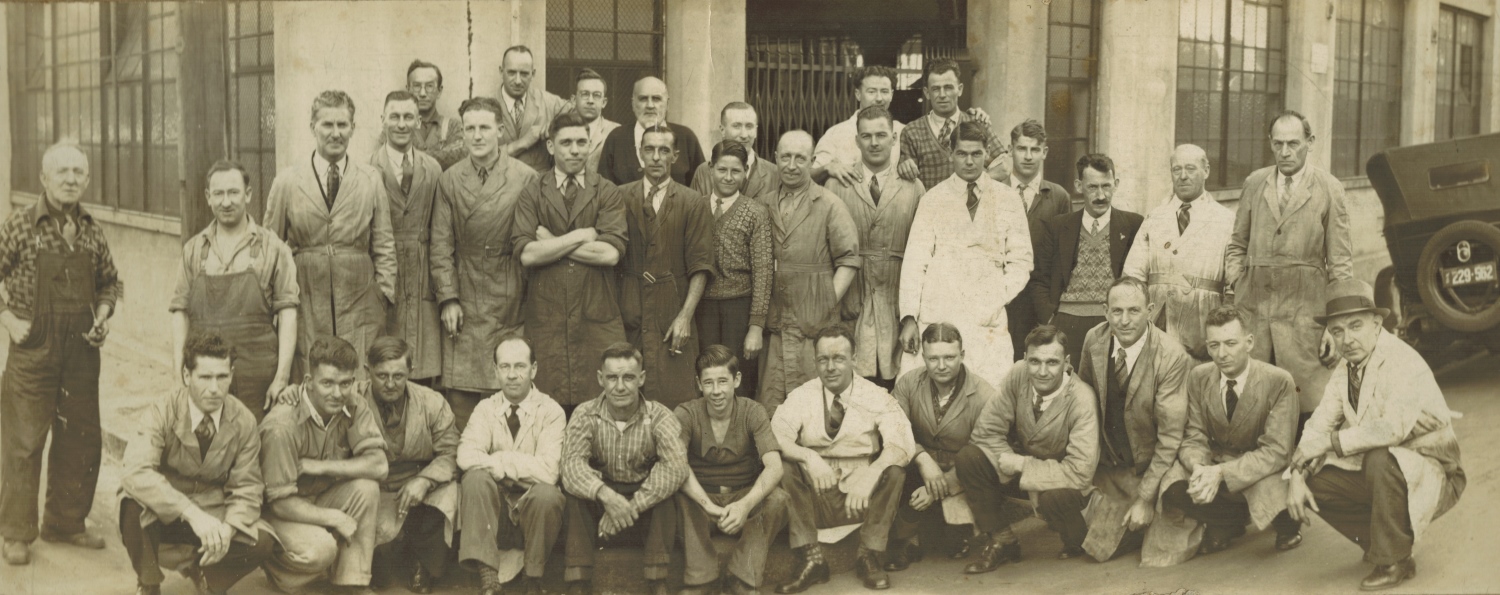
It took me a fortnight to finish this kerosene tin full of these things. When I'd finished I went over to Arch. He worked on a raised platform with a glass partition around it. I said to him: "Mr Rimoldi, I've finished that job." "OK," he said, "go and stand by your machine." I went over and stood by the machine and Arch came over in his white dustcoat. He stood there and a labourer bloke came along with a railway pushcart - with another tin of these bloody bushes on it! I was about seventeen then, about half-way through my apprenticeship. Rimoldi's standing there looking at me, and when I saw it was more bushes I muttered: "J**** f****** C*****!" He jumped on me: "Did you swear at me, son?" "No, I didn't, Mr Rimoldi." "Yes you did," he said, "you told me to get f*****!" (which actually I hadn't). There was a hell of a blue over it, and they whipped me up to the Staff Office to a bloke named Dave Stewart who was a real hard Scotsman, and they threatened me with bloody cancellation of my apprenticeship, treason,(joke!) and C***** only knows what else! So I did those bushes too. I was on them for about a month altogether. Needless to say, I've got a pretty good idea how to chamfer sixteenth of an inch holes to a mirror finish!
When the war ended Automatic Totes started to get civilian-type work back in - private work to do with the post-war redevelopment of industry in Sydney. They decided to develop a metal heat-treating department. It was only small - about as big as this lounge room - with a couple of relatively small furnaces and salt bath heat treatment liquid furnaces. They employed this bloke Arthur Reardon who had been at General Motors right throughout the war years. He was a bloke in his sixties, and we hit it off immediately - like nobody I'd ever met in my life. I suppose there might have been a bit of the grandfather thing in it, if you like, for want of a better description. But there was just something about this man that was different to anybody else I'd ever struck. There was a sincerity there, and he obviously loved what he was doing. And he was good at it. And he was recognised as being good at it.
Now my academic ability at mathematics wasn't as good as it needed to be to develop toolmaking skills. I couldn't handle trigonometry, and logarithms were a complete mystery to me. I must have missed something basic at school or something, because later on, as I used calculations in other fields that I was actually interested in like the automotive business, I found I could do all sorts of calculations regarding compression ratios and gear ratios and things. But with the engineering I wasn't really motivated, I didn't like it, and I wanted to get out of the bloody place.
Anyway, because I was failing as a fourth year apprentice, to get rid of me out of the normal work force (where I was probably seen as a disruptive element) they put me in the Heat Treatment Department with this bloke Arthur Reardon, and I was his lackey, if you like. He must have seen some potential in me that I didn't know about. I don't know why he did because by then I was 19, and I was an absolute bloody mug lair lout at that time - there's no question about it. I was going bad, I really was. Problems seemed to follow me around. I had a pretty short fuse. I'd done a bit of boxing around the place, and my answer to anyone who annoyed me or hit me was to hit them. It was one of those ridiculous situations where young blokes were a bit more inclined to do that a bit more often in those days - it was a common way to settle a difference of opinion.
As Danny has mentioned the heat treatment department above, I have included the image below, a photo taken in the Meadowbank factory.
The Heat Treatment Department
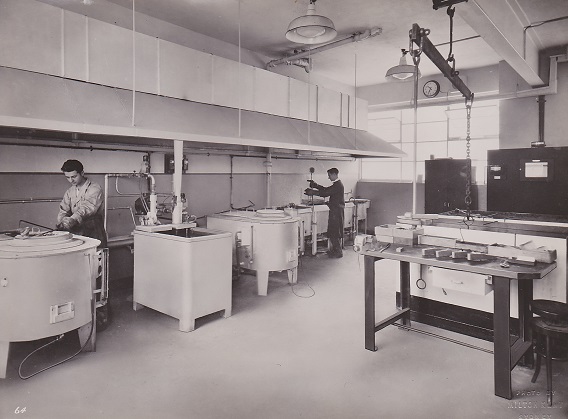
So Arthur got me interested in the technicalities and the theory of metal heat treatment. I found it absolutely intriguing. I hadn't realised its importance, and that without it nothing would work. You can't make all those intricate pieces of engineering and expect it to run unless it's been adequately heat treated so that it's hard and won't wear itself out. Arthur was the first international member of the American Society for Metals, and he got me so interested in it that by the time I was almost out of my apprenticeship he nominated me for membership and I was accepted as a junior member. I understand that there were only three of us in Australia at the time - the other two were both apprentices of Arthur's from earlier times. Doing something that I found interesting settled me down, and I applied myself to it with diligence. I stopped being a troublemaker - it was the same reason kids make trouble today - boredom - doing something that they don't want to do. But suddenly I had a reason for life and I loved it. It was interesting. It was bloody hot and dirty, but the fact that he explained what we were doing and I knew that it was serving a certain purpose... He was on the verge of developing a completely new process to be introduced to Australian industry. It was called Isothermal Heat Treatment.
We were moved into a brand new factory at Meadowbank, on the Parramatta River, and it had everything in it. Arthur and I were on top of the world. I was about to go into my fifth year, and no bullshit, we were working at 120% because we liked what we were doing, and we were doing stuff that had never been done before. We were producing a product without stress, without distortion, without cracking.
Briefly, what happens when a piece of metal is heated to the point where it changes its internal structure - it goes into what's called a state of solid solution. There are various components in the piece of metal, like iron, carbon, manganese, chrome, nickel, cobalt and so on, and every composition of metal has its place within industry to do a certain job. The critical temperature at which these elements combine in the metal varies according to the composition of the particular metal you're dealing with. Take an ordinary metal worker's file. That's straight carbon steel, and it's the hardest form of steel you can get. But as you add other metals to it, its strength and wear resistance improves, but its hardness drops. So a basic thing like a file goes into solid solution at 780 degrees Centigrade. If you go to the other end of the scale to high-speed cobalt steel, it's got a high tungsten content for resistance to wear and heat, and it'll cut at high temperatures. It goes into solid solution at a much higher temperature - around 1050 to 1100 degrees Centigrade. Then it reaches a point of hysteresis, where there's a tremendously stressful situation in that piece of steel, and as it cools down the stresses are even greater because the outside cools quicker than the inside, and this is what causes distortion and cracking. The secret that Arthur found out was that there was a critical point which the metallurgists knew about but the practical heat treaters didn't know about. The point about it was, that you didn't have to come back to room temperature. When it reaches that point of change, it changes from a spheroidal form in its molecular structure (like a whole lot of ball bearings stuck together if you look at it under a microscope) and you can actually see it take place. The furnace is red hot, and the block of steel is red hot within it, and it's all the same colour. You watch the temperature going up on the thermocouple, and suddenly the job cools within the furnace. You can see it. It has actually cooled a degree or so within itself as it changes, and that's the point where it'll harden.
Now in the old days you'd pull it out and quench it in oil, or water - (it's still got to be done that way with some materials) but with these high alloy metals it's possible to bring them down to a point above room temperature - around 450 degrees Centigrade - then hold them at that to let them stabilise. The medium that you quench it in is a hot salt or a controlled atmosphere furnace. So it comes down slowly and changes from what we call Austenite into a form called Martensite, which is a needle-like structure. The form changes from little spheres to little needles that interlock. And when it comes out of the intermediate quench it's soft and malleable - you could actually bend it or straighten it or even hammer it while it's cooling and slowly going hard. And when it gets down to room temperature it's hard and straight and undistorted. So that's what Isothermal Heat Treatment is all about, and we started it at Automatic Totalisators in 1947-48.
World War 2 Gun-sight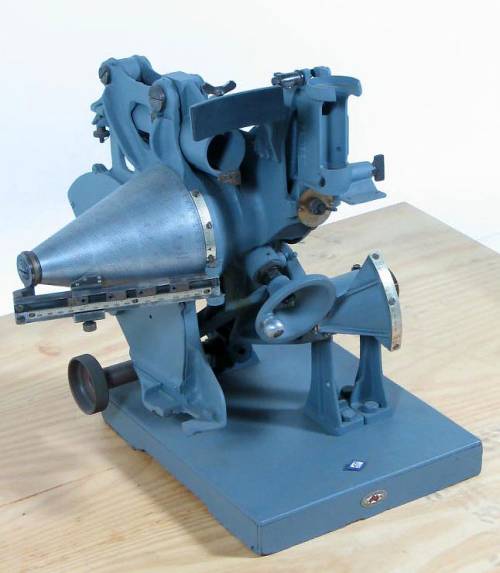
Image Source: Powerhouse Museum Sydney
So ends Danny's interview. In contrast to the type of work being performed by an apprentice, the above image is an example of the war effort products manufactured at the Chalmers Street factory, which made good use of the wealth of knowledge of the experts in Engineering and Manufacturing that worked there. The image above shows a World War Two Military Gun-sight manufactured in the precision machine shop at this factory. Note the familiar Automatic Totlisators emblem on the front of the base of this product. Business is Business even in war! The emblem is a Rugby ball shape and has Australia in the middle of it with the word PREMIER through it with MADE IN AUSTRALIA written across the top and AUTOMATIC TOTALISATORS Ltd. across the bottom.
Neville Mitchell, introduced above, wrote the following in September 2014 regarding the above interview:
What a great story. It puts a focus on the conditions that we see in the old photos of Chalmers Street. The heat treatment section at Meadowbank was a wonderful piece of engineering material conditioning with many very old techniques being combined with modern technology. The section was managed by "Bob the Red" the only ATL person who admitted he was a communist. Two names I do recall Arthur Reardon & Arch Rimoldi. Both men were tote legends. Danny Alexander's description of the New Meadowbank Factory was just as it was when I started there in 1962. The precise timing of meal breaks and knock off with the collection of all tools held by your docket number. The man who was in charge of the tool store was Ces Freeman, a genuine gentleman.
Rod Richards, introduced above, wrote the following in October 2014 about the above interview.
I enjoyed reading the story of Danny Alexander and the Heat Treatment Dept. I would have liked to have been involved in that section but it always seemed to be off limits to us besides at that time everyone had a job to do in getting machines out on time to meet installation deadlines.
The photograph shown in the image below is of a section inside the Automatic Totalisators Limited factory in Chalmers Street shown in the image at the top of this page. The adder in the foreground is a Grand Total Adder for Brough Park racetrack Newcastle Upon Tyne. The writing on the back of the photograph reads: Brough Park Newcastle - View of 3-3 shaft Grand Total machines on one frame (W.P.&F.) - Note that middle shaft of each section is speeded up. This is to enable that shaft to hold 10/- betting without unduly running the storage screws in.-Grand Totals have two units shafts (each 3 escapements) and one tens shaft to keep speeds down as at White City. W.P.&F. in this text stands for Win Place and Forecast pools.
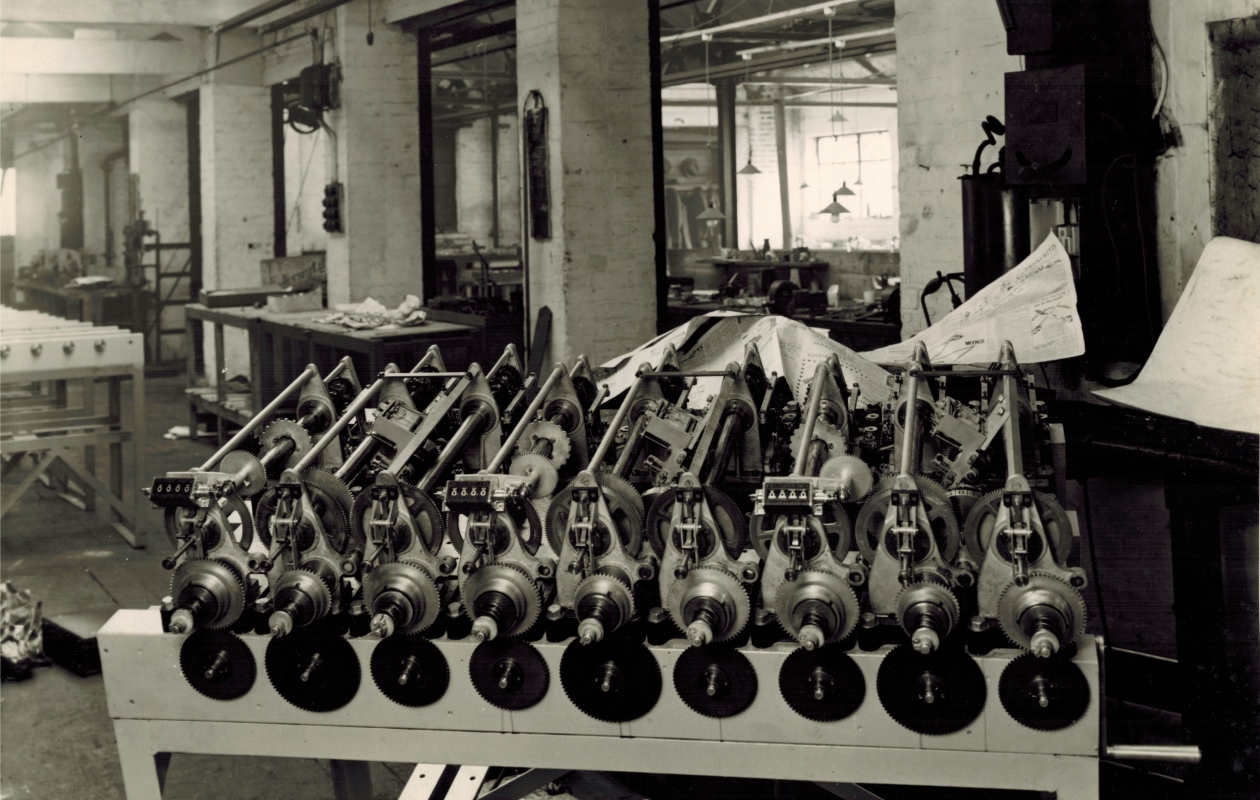 A GT Adder inside the Chalmers Street Factory
A GT Adder inside the Chalmers Street Factory
As the Brough Park racetrack in Newcastle Upon Tyne installation was performed in 1936 and Automatic Totalisators Limited moved their factory from Alice Street Newtown to Chalmers Street at the end of 1933 and start of 1934 and they did not move the factory from Chalmers Street to Meadowbank until 1947, the photograph shown in the image above must have been taken in the Chalmers Street factory.
Following is an article that appeared in issue No. 18 June 1968 of the Automatic Totalisators Limited company magazine called Tote Topics. It relates to the ATL Toolroom, which was famous. My wife was the Assistant Manager of the CES (Commonwealth Employment Service) office at Ryde when I started working at the Meadowbank factory and this factory was in her jurisdiction. She used to relate how mothers, who's son's managed to get an apprenticeship in the ATL toolroom, would be elated with the idea that their son had made it! As the following article starts with the World War II era I thought it appropriate to present it here, as the Automatic Totalisators Limited factory at that time was in Chalmers Street and that is the topic of this page. The ATL factory moved to Meadowbank in 1947. There is a single monochrome low resolution photo of the ATL Toolroom in the Meadowbank factory, which accompanies this magazine article. I do not have a higher resolution image of this photo, so I have presented some other similar and pertinent images from the Meadowbank Toolroom throughout the article. The Meadowbank factory is shown in the image above titled The Meadowbank Factory and Spencer's Buick.
The Toolmaking Division of Automatic Totalisators Limited
The name Automatic Totalisators Limited, quite naturally, sells to the majority of the general public the fact that we are a company whose interests revolve around the racing world, thus embracing our four legged friends, racetracks and the human elements of gambling. BUT, how many, with the exception of those who are engaged in or have been associated with, the business of volume production, would associate this name with something seemingly as foreign as the manufacture of precision tools and gauges for commercial use.
The fact is, we are commercial toolmakers and to explain this somewhat surprising set of circumstances, let us look back into the history of A.T.L., in particular, the period during and after the last war.
During the war, the toolroom was employed in the manufacture of tooling for Munitions, a factor which proved of considerable value in post war years, when the accrued knowledge and machinery were used to considerable advantage in the manufacture of Totalisator Tooling. At this period, it was also found that the production requirements of industry were increasing and it was this factor which prompted the move into an additional field to the Totalisator Market and Automatic Totalisators Limited thus became toolmakers to the trade.
As tooling is mentioned above, I have included the following image of some of the tooling racks at the Meadowbank factory. All the following supporting images for this article were also photographed inside the Meadowbank Factory.
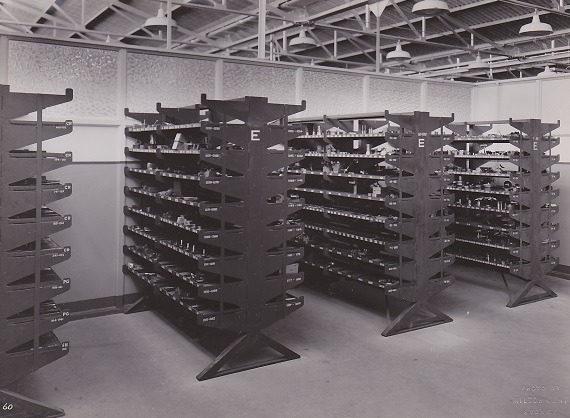 Some of the tooling storage racks
Some of the tooling storage racks
To the uninitiated, a toolroom is a place where hammers, spanners etc., are manufactured. This obviously is not the case, for while these items could be made quite adequately in the toolroom the individual cost would be astronomical as these items are basically volume production. However, the tools from which these items are produced, could be, and are made quite successfully and economically in our toolroom.
To describe our facilities and function in detail, would be both lengthy and boring, but as a starter, let us say we are specialists in the manufacture of high class tooling such as Press Tools, Moulds, Jigs, Fixtures and Gauges. Those who are familiar with tooling will readily see that this modest statement virtually covers the entire range of tooling requirements anyway.
Toolmakers Hand Fitting Section
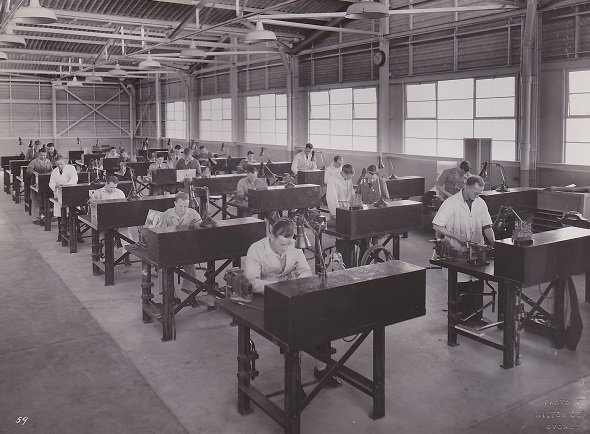
Note: The above image shows where the various dies jigs and fixtures were assembled and checked out.
The tooling from which everyday items are produced is employed by the manufacturer in the production of items whether they be from plastic or metal. Items such as body panels for cars are produced from a press tool. The telephone handset is produced from a plastic mould and high precision gauges are used to ensure the intricate dial mechanisms, incorporated in the phone, comply with specifications laid down by the P.M.G.
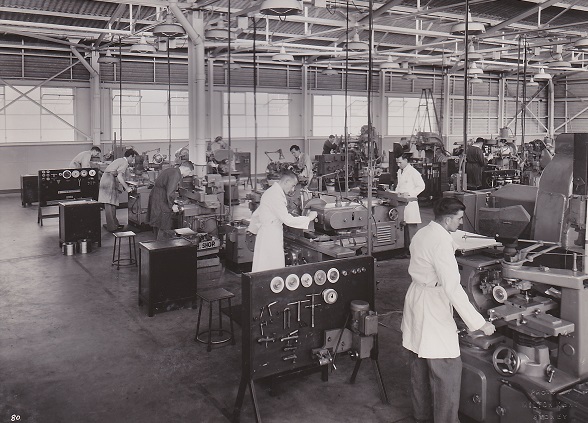 Precision Grinding Department
Precision Grinding Department
As the article mentions grinding machines next, I have included the above image of the precision grinding department with surface grinders, centreless grinding, jig boring and overhead milling machines.
To facilitate the efficient manufacture of this type of high class tooling, good quality machine tools are a necessity. These fall into two basic classes, namely:
- The conventional or basic machine, such as lathes, milling machines surface and cylinder grinding machines and drilling machines etc.
- The more sophisticated machine tool which is used for the specialised operation, so necessary to enable compliance with today's requirements. Our range of this type of equipment includes machines such as Jig Borers, Jig Grinders, 3 Dimensional Pantographs, Electrical Discharge Machines and Optical Profile Grinders.
As the article mentions milling machines above, I have included an image of the Precision Milling Department below.
Precision Milling Department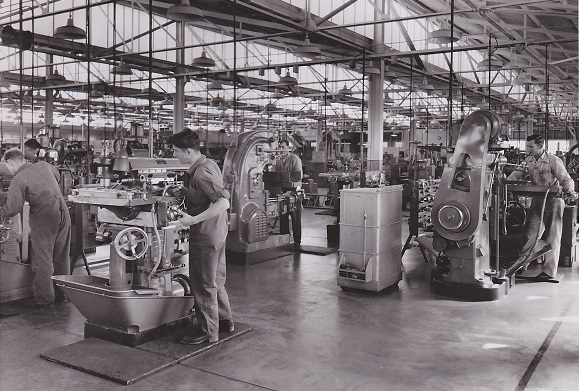
The need for this type of specialised equipment has increased dramatically over the past ten years, a condition which can be more readily appreciated if we look at the everyday items such as the modern motor car and its associated fittings, lawnmowers, T.V. sets, the telephone with its associated switchgear. All these items, and many more too numerous to mention, have been accepted as part of our way of life, but very few people, quite naturally, would appreciate the problems associated in producing these items, or to be more exact, give any thought as to how they are produced.
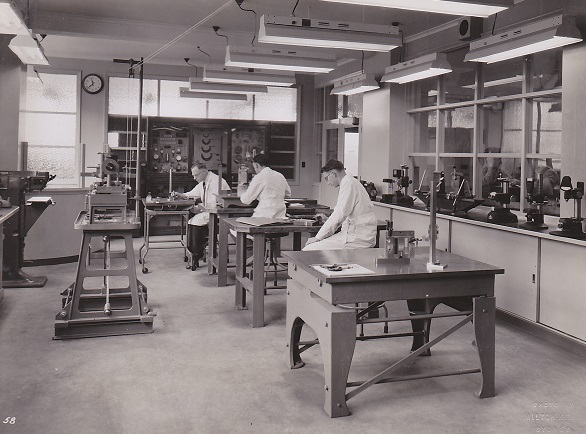 A section of the Metrology Laboratory
A section of the Metrology Laboratory
To ensure we produce the desired result in the manufacture of all types of quality tooling we have a Metrology Section, through which all work must pass and be certified as correct to drawing dimensions. This section is approved by the National Association of Testing Authorities and Department of Civil Aviation, to certify that work performed in the toolroom or for that matter, work performed by anyone is acceptable at the standards laid down by these various departments.
All inspection work is carried out in air conditioned surroundings, utilising the most modern metrology equipment available. The Commonwealth Government would be our largest customer in this field, and constantly request our certification of various types of gauges, whether we have made them originally or not.
The combination of skill, high precision equipment, and the reputation of being able to produce a quality tool, whether it be press tool, mould, jig, and fixture or gauge, has given us the right to add the bi-line of "Toolcraftsmen to Modern Industry" to the name of Automatic Totalisators Limited.
J.A.
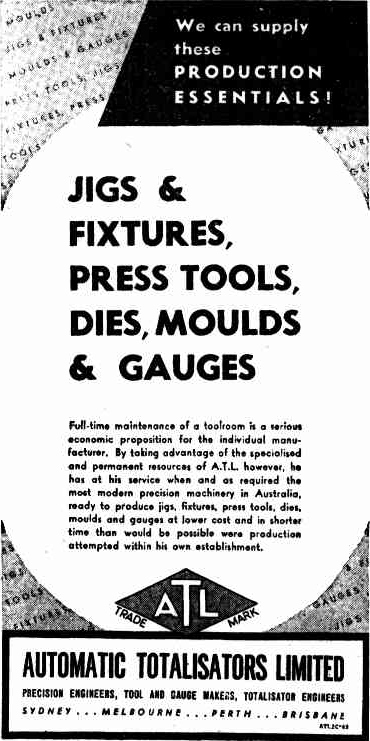
Advertisement in the Truth Newspaper 1945 for ATL Toolroom
Following is an extract of an advertisement for the ATL Toolroom from the Trove digitised newspaper archive which appeared in the Truth newspaper dated 1st April 1945:
Citation: 1945 'Advertising', Truth (Sydney, NSW : 1894 - 1954), 1 April, p. 13. , viewed 17 Jan 2017, http://nla.gov.au/nla.news-article169362056
In the top right hand corner in a black trapezoid with white text:
We can supply
these
PRODUCTION
ESSENTIALS!
Centre with large black text:
JIGS &
FIXTURES,
PRESS TOOLS,
DIES, MOULDS
& GAUGES
Small black text below the above text:
Full-time maintenance of a toolroom is a serious
economic proposition for the individual manu-
facturer. By taking advantage of the specialised
and permanent resources of A.T.L however, he
has at his service when and as required the
most modern precision machinery in Australia,
ready to produce jigs, fixtures, press tools, dies,
moulds and gauges at lower cost and in shorter
time than would be possible were production
attempted within his own establishment.
Below the above text is the once famous ATL diamond logo.
Below the diamond logo inside the rectangle are three text lines following:
AUTOMATIC TOTALISATORS LIMITED
PRECISION ENGINEERS, TOOL AND GAUGE MAKERS, TOTAL1SATOR ENGINEERS
SYDNEY...MELBOURNE...PERTH...BRISBANE
The minute text below the lines above and on the far right hand side inside the rectangle reads: ATL2C-45
And now we fast forward to my era. By the time I joined ATL in 1977, the toolroom had grown to the extent that it required its own premises and was located on the other side of Nancarrow Ave to the factory. The image below shows the separate toolroom building, which according to the document below, was established in 1971.
Automatic Totalisators Limited Toolroom
Following is an extract from an Automatic Totalisators Limited document titled Automatic Totalisators Limited Toolroom which contains the following image along with several others. The writing on top of the building comes as no surprise and reads Automatic Totalisators Limited Toolroom. The Parramatta River can be discerned in this image, below the buildings on the far bank near the horizon, when looking down the right hand side of the Toolroom Building. This is the Parramatta river that Neville Mitchell referred to in his comment above in the Spencer Grace section, starting I never met Spencer Grace, I did see him sculling on the Parramatta river in front of the Meadowbank factory, when working overtime which was quite often.
The ATL Toolroom across the road from the Meadowbank factory
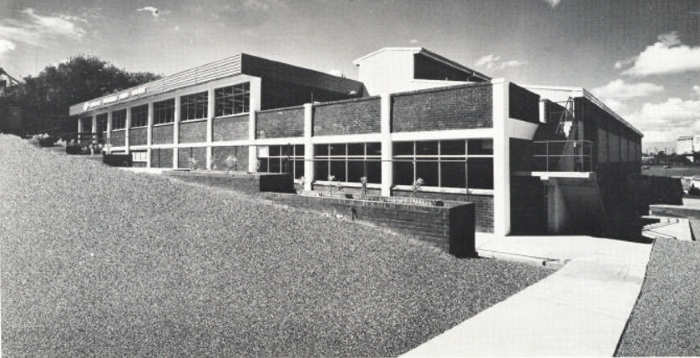
Automatic Totalisators Limited's Commercial Toolroom
Specialists in high precision manufacture of all classes of Tool Steel and Tungsten Carbide Segmented Progressive Dies, Fine Blanking Dies, Plastic and Die Cast Moulds, Jigs, Fixtures, Gauges and Special Purpose Machine Tools. Our own Tool Design service is available to clients where these details are not provided.
ATL Toolroom offers ...
Custom Precision Machining Services
Jig Boring, Jig Grinding, Profile Grinding and Electrical Discharge Machining.
Custom General Machining Services
Turning, Milling, Cylindrical and Surface Grinding.
Metrology Services
N.A.T.A. and D.C.A. approved. Webmaster's comment: When I started flying in 1972, D.C.A. was the Department of Civil Aviation. As it has not been called this for a long time I thought I should point it out.
Automatic Totalisators Limited, a public company, was formed in 1917 to manufacture, install and operate Totalisator systems throughout the world. Today, major racing centres in 30 countries use Totalisator equipment--electro-mechanical and fully electronic--designed and manufactured by ATL.
The Toolroom, which was initially established to supply tooling for totalisators, expanded through the war and post war years to become one of the largest commercial Toolrooms in the Commonwealth. Industries supplied now include domestic appliance, telecommunication, munitions, aircraft manufacture, automotive, canning and packaging.
In November, 1971, the Toolroom was relocated in new premises opposite the main factory in Nancarrow Avenue, Meadowbank, N.S.W.
The new Toolroom has a 30,000 square feet factory area, completely equipped with modern services and staff facilities. The separate precision rooms for Metrology, Jig Grinders and Jig Borers are fully air conditioned and contain some of the most modern precision equipment and machinery in Australia.
Tool Maintenance Department
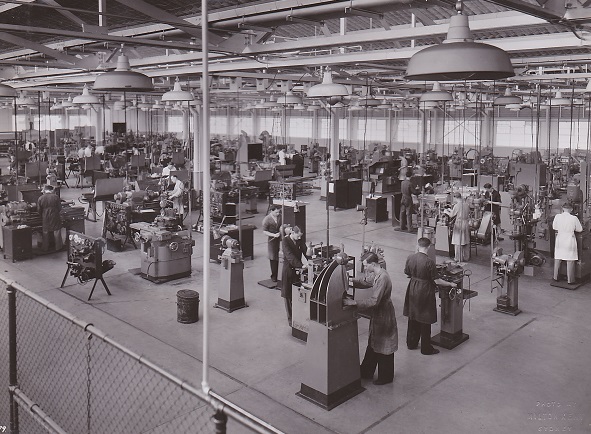
A constant replacement and repair policy keeps the Toolroom's machines, tools and equipment at peak standards throughout all sections. The Shop is adequately equipped for all classes of precision work up to two tons in weight. Its manufacture is supported by a large N.A.T.A. and D.C.A. approved Metrology Laboratory.
The rest of this document illustrates the Toolroom and its services and equipment and provides some examples of recent output which I have not included to avoid getting bogged down.
Frank Matthews, who was the last Senior Partner of Julius Poole and Gibson, George Julius' engineering consulting company, wrote the following after reading about the ATL Toolroom here: I recall Awdrey Julius taking me out to Meadowbank about 1956 and showing me, with pride, the tool room. Awdrey Julius who Frank mentions was George Julius' son. There is information about Julius Poole and Gibson and Frank Matthews in the Sir George Julius chapter of this website. To read this, select the Go to the index button in the Nav Bar at the bottom of this page and select the suggested chapter and scroll down to the heading Julius Poole & Gibson The Original Partners which is the start of the Julius Poole & Gibson section.
Bill Johnson wrote the following about the toolroom at Meadowbank, shown in the image above titled The ATL Toolroom across the road from the Meadowbank factory:
Our Marketing Division office and workshop was built at the end of the tool room, across the road after the tool room moved. We had to walk through the tool room machines to access our workplace.
I remember having to unload a shipment of car parking equipment for installation in Canberra. It was a winter installation and so cold it slowed down the soldering of wires to their terminals.
After Reading about the ATL Toolroom above, Dermot Elworthy wrote some interesting comments about it. Dermot is George Julius's great nephew and a retired mechanical engineer who also was a professional pilot.
Dermot once told me that somewhere in a dusty Academe Basement there must reside a crumbling dissertation submitted fifty years ago and entitled Determination of Adiabatic and Isothermal Conditions as Applied to Sleeve-Valved, Spark Ignition Internal Combustion Engines. He doubts if the invigilating authorities bothered to read beyond the pretentious title but whimsically supposes that his Uncle George might have found the work of some small merit.
Dermot, as a small boy living in New Zealand, actually met George Julius shortly after the end of the War. Following is Dermot's comments about the ATL Toolroom:
As you anticipated, I found the toolmaking division of particular interest. I was surprised that there was no mention made of a shaper (a machine tool now somewhat ancient) and even more surprised that spark erosion was being employed. That was quite a novel process at that time.
The mention of jig grinders took me back a few years for I used to operate a large Pratt and Whitney jig grinder in the production of precision press tools. The tool room was about 70 yards from the local train station and I had a timetable on the wall to monitor train movements. I was obliged to stop work as these things thundered past; their passage could be seen in the surface finish of the workpiece!
I am sorry to report that at the time of adding the Toolroom content above in January 2017, I had been in Sydney the month prior to attend the annual ATL Reunion Dinner. Whilst there, Bob Plemel, the ex ATL Engineering Manager and I visited the ATL Meadowbank factory site which at the time was a hole in the ground with construction work in progress building apartment blocks. This is part of a process transforming the whole area from industrial to up-market residential and includes the ATL Toolroom shown in the second image above, which also was a hole in the ground when we visited. The Meadowbank factory as it was in ATL's time can be seen in the second image in this page.
Never mind, the Chalmers Street factory building is still standing in the city and looking very respectable. It is the only ex ATL factory building left standing. To see an image of the Chalmers Street Factory as it looked in 2014, click on the image at the top of this page showing the factory in the late 1930s, then scroll up to and select the previous image icon in the Photo Gallery directory.
Kevin Shaw, who used to include the Meadowbank ex ATL factory in his historic tours of the Ryde district and happened to work for George Julius' organisation the CSIRO for 31 years, wrote the following about the demolition of the factory:
I am sorry about the destruction of the Meadowbank building, and also because I did not forewarn you. The Art Deco frontage survived briefly when the rear was removed about 15 years ago but then the juggernaut of apartment developers arrived, and even though the ATL building was on Ryde's heritage inventory, it was only considered of local significance and was not spared. I am afraid I have lost hope about heritage in Ryde and I did not stand in front of the bulldozers.
However, I am pleased that the Chalmers St building has survived as it may represent the golden age of ATL. I am reminded of C Northcote Parkinson's adage that you can write off a company when it moves into its new building. Mind you, I am not sure I believe that adage and the pictures from Meadowbank portray a model of efficiency, don't they? Thank you for keeping me in the loop.

- Thanks to Phil Grace for approval to use information from his eulogy, which was published in the Sydney Morning Herald.
- Thanks to Maurie Grace for the information from his eulogy, which was used at Spencer's funeral.
- Thanks to Jess from the National Library of Australia, for informing me that articles in the Trove Australian Newspapers on line website, published prior to 1955 are out of copyright and consequently can be used on this site without having to seek approval.
- Thanks to Matthew Connell, Principal curator Powerhouse Museum for providing approval to use the image of the WW2 gun-sight.
- Thanks to Neville Mitchell for his emails relating to Spencer Grace and the Danny Alexander information. Additionally for providing the images of the ATL Toolroom.
- Thanks to Peter Collier for the copy of Tote Topics Magazine No.18 June 1968 and the document titled Automatic Totalisators Limited Toolroom.
- Thanks to Malcolm Coutts regarding his memories of Spencer Grace and rowing.
- Thanks to William Johnson regarding his memories of Spencer Grace and Automatic Totalisators.
- Thanks to Rod Richards for his observation of Spencer Grace, his recollections of working at the new Meadowbank factory and for his comment on the ATL Heat Treatment Department.
Comments and suggestions welcome to totehis@hotmail.com 
The "Next page" button below presents the previous Automatic Totalisators Limited factory to this one which was in Alice street Newtown.


 Part of the Assembly Section
Part of the Assembly Section
 Go back to the index
Go back to the index



 A GT Adder inside the Chalmers Street Factory
A GT Adder inside the Chalmers Street Factory
 Some of the tooling storage racks
Some of the tooling storage racks

 Precision Grinding Department
Precision Grinding Department

 A section of the Metrology Laboratory
A section of the Metrology Laboratory



